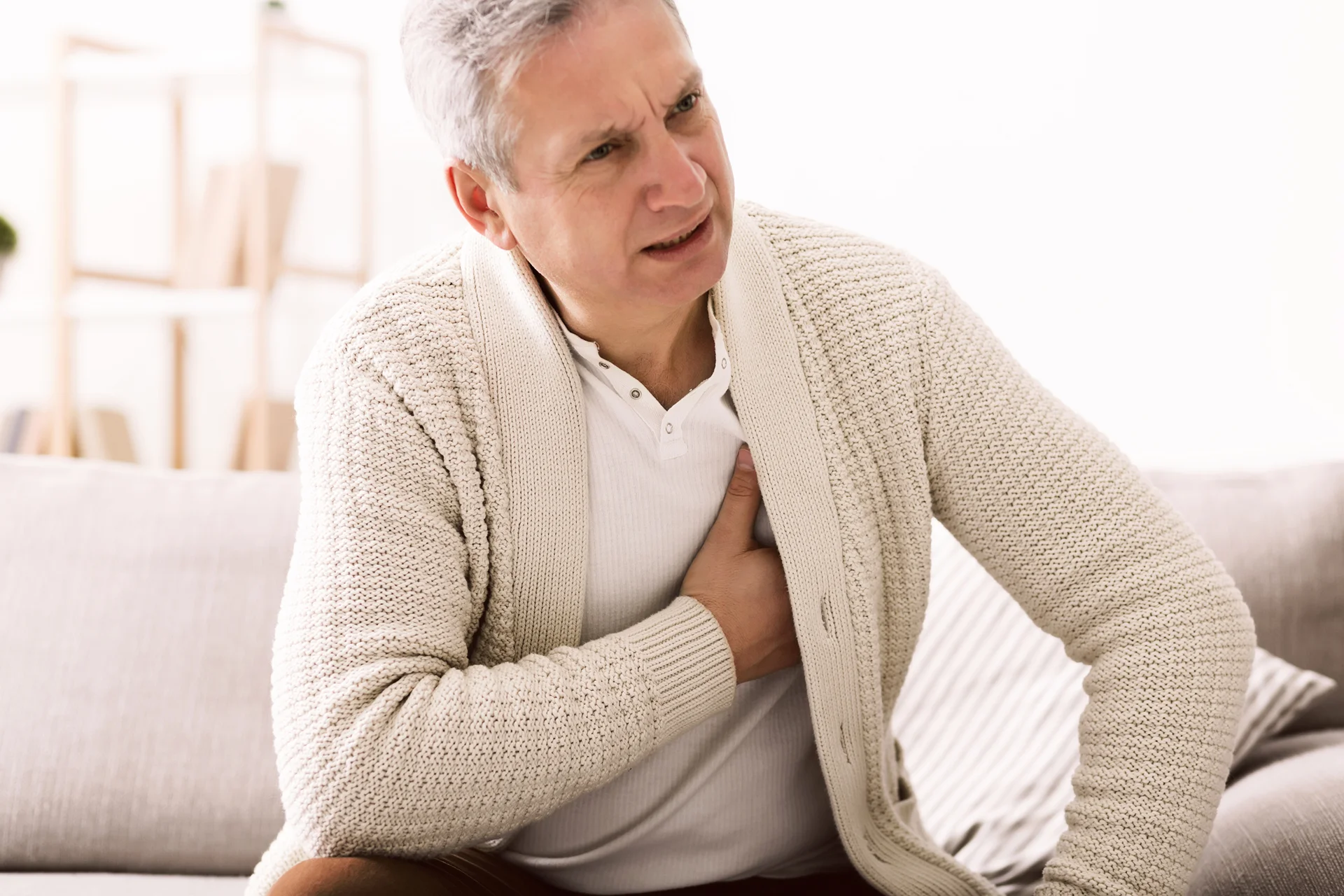Few things can halt your day in its tracks faster than a sudden vice-like grip of chest and back pain. Did you know that an estimated 20-40% of adults experience chest during their lifetime and over 5-7 million ER visits happen annually in the U.S. alone?
The bright side is that getting a handle on chest and back pain is possible. With the knowledge about what causes these symptoms, what warning signs to watch for, and what treatments bring real relief, you can break free from the frustration and anxiety this discomfort often sparks.
What Causes Chest and Back Pain?
Chest and back pain can arise from many different sources. Here are some of the most common culprits:
Heart Conditions
Since the heart resides within the chest cavity, cardiac issues often produce chest pain. Angina, angina pectoris, and even heart attacks typically cause chest tightness or pressure that may radiate to the back, left arm, neck, or jaw.
Pericarditis, an inflammation of the sac around the heart, also produces sharp chest pains that may worsen when lying down or breathing deeply.
Lung Conditions
Lung infections like pneumonia or pleurisy can cause sharp chest pains, especially when breathing. A pulmonary embolism, a blocked artery in the lungs, causes sudden shortness of breath and chest pain.
Pneumothorax, a collapsed lung, also leads to chest and upper back pain.
Digestive Problems
Indigestion, heartburn, ulcers, pancreatitis, and gallstones can provoke pain or burning sensations in the upper abdomen that radiate into the chest. The pain may worsen after eating.
Injuries
Muscle strains and injuries to the chest wall, ribs, or upper spine can produce localized chest and back pain. Slipped discs or fractured vertebrae in the upper back may cause sharp pains that radiate around the chest.
Spinal Conditions
Arthritis, spinal stenosis, and degenerative disc disease in the upper spine can all contribute to stubborn upper back and chest wall pain. Pinched nerves in the thoracic spine can also cause pain that radiates to the ribs or chest.
Anxiety Disorders
Anxiety and panic attacks produce chest tightness, pain, and shortness of breath. The chest wall muscles can spasm and tighten, provoking pain that comes and goes.
As you can see, chest and back pain have a wide variety of potential causes. Keep reading to learn about the common symptoms that point to an underlying condition.
What Symptoms Accompany Chest and Back Pain?

In addition to localized pain, other concerning symptoms may indicate a more serious health issue requiring prompt medical attention. Watch out for:
- Sharp, stabbing pains or pressure in the chest, back, arms, neck, or jaw
- Pain or discomfort that radiates from the chest area to the upper back or vice versa
- Shortness of breath or difficulty breathing, especially when active
- Lightheadedness, dizziness, clammy skin, or loss of consciousness
- Nausea, vomiting, sweating, or palpitations
- Cough, fever, inflammation, or swelling in the chest or back
- Pain that worsens when breathing deeply, lying down, eating, or moving
- Persistent pain lasting more than a few days
Any of these additional symptoms in tandem with acute chest or back pain warrant a medical evaluation. Let’s explore when it’s crucial to seek emergency care.
When to Seek Emergency Care for Chest and Back Pain
While many instances of chest and back discomfort can be managed at home, some require prompt medical attention to prevent complications. Seek emergency care if you have:
- Severe, crushing chest pain or tightness
- Pain spreading to the back, arms, neck, or jaw
- Shortness of breath, sweating, nausea
- Lightheadedness, confusion, or loss of consciousness
- Risk factors like old age, heart disease, diabetes, smoking, or obesity
- Inability to identify the cause of the pain
- Persistent pain lasting more than 15 minutes
Don’t try to tough it out when experiencing any of the above. Call 911 or head to the nearest emergency room. Prompt treatment can make all the difference, especially with potentially life-threatening conditions like heart attacks.
Comparing Heart-Related Chest and Back Pain Issues to Musculoskeletal Ones
This can help differentiate the origins when you experience discomfort in these areas.
| Category | Heart-Related Chest/Back Pain | Musculoskeletal Chest/Back Pain |
| Causes | Blocked heart arteries AnginaHeart attackPericarditis | Muscle strainInjuriesArthritisSlipped discs |
| Location | Center or left side of chest May radiate to the back, arms, neck, or jaw | Localized to chest wall, ribsMid upper back |
| Quality | Tight squeezingPressureFullness | Sharp, stabbingAchy, soreness |
| Triggers | ExertionEmotional stress | TwistingLiftingPoor posture |
| Timing | Episodes at rest or with activity | Often follows movement or injury |
| Risk Factors | SmokingObesityDiabetesHigh blood pressure High cholesterol | Spinal abnormalitiesWeak muscles Repetitive motions |
| Related Symptoms | Shortness of breathNauseaDizzinessPalpitations | Muscle spasmsReduced mobilityTingling/numbness |
| Diagnostic Tests | EKGCardiac blood testsStress testEchocardiogram | X-rayMRIDisc imaging Musculoskeletal exam |
How is the Cause of Chest and Back Pain Diagnosed?
To pinpoint the origin of your chest or back discomfort, your doctor will utilize:
Medical History
Your doctor will ask about your symptoms, risk factors, and any prior medical conditions. Information like when the pain started, what makes it better or worse, and whether it radiates to other areas helps pinpoint the source.
Physical Exam
The doctor will likely perform a more thorough physical exam focused on the back to pinpoint the source of pain.
- This may include assessing range of motion by having you bend, twist, and extend the spine in different directions.
- Muscle strength testing could also be done, having you resist pressure while flexing or extending parts of the back.
- Reflex testing with a reflex hammer and sensory tests like pinpricks might reveal nerve dysfunction.
- Observing your posture and gait can reveal abnormalities.
- Palpating along the spine helps localize areas of tenderness or muscle spasms.
Diagnostic Tests
In addition to imaging like X-rays, CT scans, and MRIs, other diagnostic tests may be used to evaluate back pain.
- Electromyography (EMG) assesses nerve and muscle function by measuring electrical activity.
- Nerve conduction studies test how well nerves transmit signals.
- Bone scans can detect stress fractures or arthritis in the spine.
Putting together your history, exam findings, and test results allows an accurate diagnosis of the pain’s origin. Next, let’s explore the many options to find relief from chest and back discomfort.
How to Find Relief
Whether your chest and back pain stems from strained muscles or an underlying condition, a variety of treatment approaches can help manage it:
Medications
Over-the-counter NSAIDs like ibuprofen or naproxen reduce inflammation and pain. Muscle relaxers ease spasms while prescription pain meds provide temporary relief for severe pain.
Lifestyle Changes
Improving posture, sleep habits, nutrition, and stress levels helps minimize flare-ups. Quitting smoking and losing weight also reduces pain triggers.
Physical Therapy
Stretches, exercises, ultrasound, and massage help relax tight chest and back muscles. Proper movement patterns are taught to avoid re-injury.
Complementary Therapies
Chiropractic, acupuncture, cupping, aromatherapy, and heat/cold therapy can alleviate pain and promote healing. Deep breathing exercises also help relax the chest.
Surgery
If chest or back pain stems from severe spinal disorders, organ damage, or compressed nerves, surgery may be required. Examples include spinal fusions, rib resections, or artery stenting.
The right treatments for your situation depend on the diagnosis and severity. Work with your doctor to create the most suitable plan.
Preventing and Managing Chest and Back Discomfort
While it’s impossible to avoid chest and back pain 100% of the time, you can reduce episodes through prevention and self-care:
- Maintain good posture during activities and avoid slouching, twisting, or bending awkwardly. However, adjusting your posture too extremely (like sitting up very straight) can also cause pain in some cases, so be careful.
- Make ergonomic adjustments to your workstation and sleeping area.
- Apply heat or cold packs to the chest and back muscles to relax tension. Check with your doctor first.
- Incorporate gentle stretching and exercises like yoga into your routine. However, always warm up and stretch properly before exercise to avoid injury.
- Use stress management techniques like meditation, nature sounds, or music therapy.
- Follow treatment guidelines from your doctor, whether medications, therapy, or lifestyle changes.
- Quit smoking, lose excess weight, and make heart-healthy nutrition choices.
- Don’t brush off chest pain since it may signal a severe issue like cardiac arrest. Get emergency help for abrupt chest discomfort lacking an obvious cause.
- Recurring or intensifying back pain might also indicate serious diseases in some cases, like malignancies. Consult your physician for constant backaches that linger or worsen.
- Executing postural exercises and stretching is paramount for correcting stance and quelling chest and back discomfort.
- Preserving a balanced weight and nutritious diet assists in decreasing irritation that adds to backaches.
- Bonding with loved ones and evading seclusion can additionally aid in comforting pain.
- Be gentle with yourself and take time to recuperate if necessary.
Seeking medical guidance at the first twinge of pain can help minimize progression. But talk to your doctor right away if symptoms worsen or become intolerable.
Get Answers for Your Chest and Back Pain

Chest and back discomfort is frustratingly common, but very treatable in most cases. Understanding the wide range of causes, being aware of concerning symptoms, and utilizing all treatment avenues can help reduce aggravating flare-ups.
Work closely with your medical providers to determine the source of your discomfort, rule out serious conditions, and craft a tailored pain relief plan. With proper prevention and prompt treatment when necessary, you can get back to pain-free living.
Our seamless platform connecting patients with healthcare providers improves access to top-quality care when you need it most. Finding the right doctor and care plan for your health concerns is easy with Kaly.
